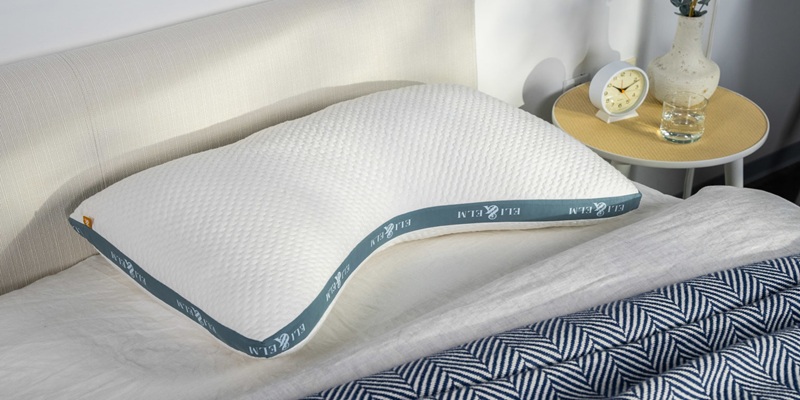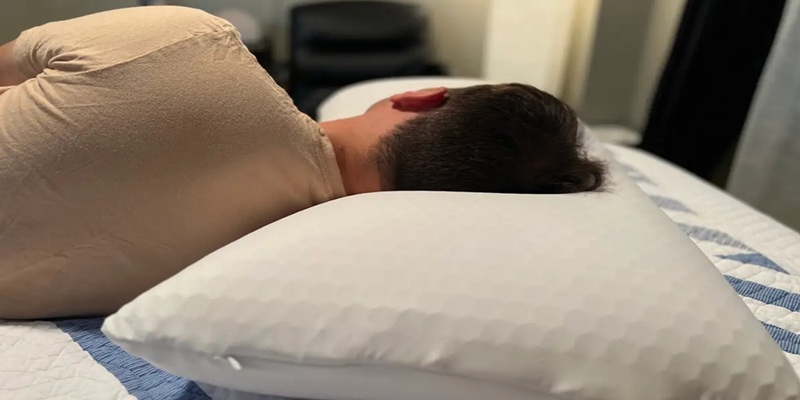Best Pillow For Side Sleeper With Neck Pain
Neck pain affects many side sleepers, often due to poor spinal alignment. Choosing the best pillow for side sleeper with neck pain is crucial, as proper support reduces strain and enhances comfort. The right pillow with optimal height and firmness helps prevent pain, promoting restful sleep and better overall health.
Neck pain affects many side sleepers, often due to poor spinal alignment. Choosing the best pillow for side sleeper with neck pain is crucial, as proper support reduces strain and enhances comfort. The right pillow with optimal height and firmness helps prevent pain, promoting restful sleep and better overall health.

Why Neck Pain Happens With Side Sleeping
Neck pain in side sleepers often stems from poor spinal alignment caused by an unsuitable pillow. If a pillow is too high or too low, it strains neck muscles and creates an unnatural bend in the cervical spine, worsening discomfort.
Proper support is crucial for maintaining a straight spine from the head to the sacrum. Inadequate elevation can twist the neck, while shoulder pressure may contribute to misalignment and soreness. Choosing a pillow that ensures proper height and alignment helps alleviate pain and promotes restorative sleep.
Key Features To Look For In a Pillow
Choosing the right pillow to alleviate neck pain for side sleepers hinges on several essential factors. Support and Alignment are crucial; a quality pillow should help maintain the spine's natural Alignment, preventing the neck from bending uncomfortably during sleep. Proper positioning is key to avoiding muscle strain and preventing chronic neck pain.
Next, one must consider Loft and Firmness. A loft between 4 and 6 inches is generally recommended for optimal head elevation for side sleepers. A pillow that is too low can cause neck strain, while one that is excessively high can place unnecessary Stress on the cervical spine. Firmness is another important feature; a medium-firm pillow typically provides the proper support without compromising comfort.
Lastly, the materials used in pillow construction can significantly impact its effectiveness. Memory foam adapts to the head and neck shapes, offering contouring support that soothes pressure points. Latex pillows are known for their resilience and consistent support, while down pillows provide a plush comfort that might need regular fluffing to maintain the loft. Each material offers distinct advantages that can enhance sleep quality and minimize neck pain, underlining the importance of making an informed choice based on personal preferences and sleeping habits.
Top Recommendations For The Best Pillows
1. Memory Foam Pillow
Memory foam pillows have gained popularity among side sleepers for their ability to conform to the unique shape of the head and neck. This material reacts to body heat, softening to evenly distribute pressure and cradle the neck, which is essential for spine alignment and pain relief while sleeping.
Pros:
Outstanding support for the neck and head
Distracts pressure from sensitive areas
Versatile for various sleeping positions.
Cons:
Some memory foam pillows retain heat
Users may find them overly firm.
Price Range: $30 - $120
2. Cervical Support Pillow
Cervical support pillows are expertly designed to uphold proper spinal Alignment during sleep. Their unique contoured design cradles the cervical spine, making them an excellent choice for side sleepers who frequently wake up with neck pain. These pillows help distribute weight evenly and prevent muscle strain by supporting the natural neck curve.
Pros:
Encourages proper spinal Alignment
Diminishes neck strain
Generally machine washable
Cons:
An adjustment period may be necessary
Some users may find them bulky.
Price Range: $40 - $150
3. Adjustable Loft Pillow
For those seeking personalization, adjustable loft pillows are a superior choice. Typically equipped with removable fill, users can modify their height and firmness to suit their preferences. This adaptability caters well to all types of sleepers, especially side sleepers needing extra elevation for spinal Alignment.
Pros:
Customizable to meet individual sleeping needs
Supports various sleeping positions
Can be re-adjusted as preferences evolve.
Cons:
It may take time to find the perfect height
The fill may become lumpy over time.
Price Range: $50 - $200
4. Latex Pillow
Renowned for their durability and support, latex pillows are made from natural latex, offering firm assistance with a buoyant quality that helps keep the head elevated. This adaptability is particularly beneficial for side sleepers who require additional support to avert neck strain and discomfort overnight.
Pros:
Long-lasting and resilient
Naturally hypoallergenic and resistant to dust mites
Both comfortable and supportive
Cons:
Price can be on the higher end
Some may perceive them as overly firm.
Price Range: $70 - $200
5. Buckwheat Pillow
An excellent eco-friendly option, buckwheat pillows utilize buckwheat hulls to offer natural support, which is particularly beneficial for side sleepers. These pillows conform to head and neck shapes while promoting airflow, ensuring a more incredible night's sleep. They are known for providing excellent firm support and helping to maintain proper Alignment throughout the night.
Pros:
Adjustable fill allows for customized comfort
Supports proper Alignment of head and neck
Eco-friendly and encourages breathability.
Cons:
Weight and noise of hulls may be off-putting
The texture can be unfamiliar to new users.
Price Range: $40 - $120

Conclusion
Selecting the right pillow can improve sleep quality for side sleepers battling neck pain. By understanding each pillow's unique benefits and pros and cons, individuals can make informed choices that promote comfort and better sleep.



